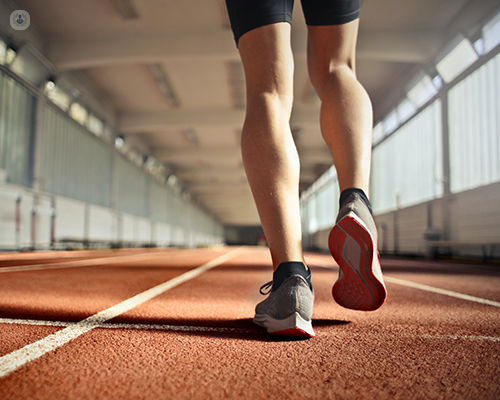Achilles heel injury: What are my treatment options?
Written in association with:The Achilles tendon is a band of tissue, located at the back of the lower leg, that is used when walking, running and jumping. While the Achilles tendon can withstand great stresses from these movements, it is also prone to irritation, inflammation, resulting in injury.
Here to provide an expert insight into an Achilles heel injury, including types, symptoms and treatment, is Mr Paul Hamilton, renowned orthopaedic consultant based in London and Ashtead.

What is an Achilles heel injury?
An Achilles heel injury refers to any damage or injury that affects the Achilles tendon. This is the largest tendon in the body, and connects the calf muscle to the heel bone.
There are two main types of injury:
- Achilles tendonitis: The Achilles can become painful and swollen. This is usually an overuse injury, and can affect walking and running.
- Rupture: A rupture can occur when excessive force is put through the Achilles, such as in sport, usually involving a sudden impact or pivot.
Why are Achilles heel injuries increasing?
There are multiple reasons why Achilles problems may be increasing. They often relate to overuse injuries or sudden changes in activity, especially in people who have been previously sedentary. Lack of proper warm-up and stretching along with improper unsupportive shoe wear can contribute. Age, obesity and certain medications also weaken the tendon, and thus may be a factor.
How can you prevent an Achilles heel injury?
It is important to warm up and stretch before exercise and wear appropriate shoe wear. Maintaining a healthy weight and gradually conditioning the tendon on starting or returning to activity or sports will also prevent injury.
What are the symptoms of an Achilles heel injury?
Symptoms of Achilles tendonitis are usually pain and localised swelling in the Achilles that is often worse in the morning or after activity. In cases where the Achilles has ruptured, there is often sharp pain, snapping or popping at the Achilles, and people often describe being hit at the back of the Achilles.
Injury is more common in jumping, running or sudden start stop sports, such as football and badminton. Tendonitis is also more common in people with a high arch or flat feet.
How are Achilles heel injuries diagnosed?
Diagnosis can be made after discussion and examination by an orthopaedic foot and ankle consultant.
Classically, in a rupture when the calf is squeezed, there is no movement of the foot, indicating that the tendon is no longer attached to the heel. Imaging can confirm the diagnosis and can help guide treatment. Ultrasounds are most used, although MRI scans can be used in complex cases.
How are Achilles heel injuries treated?
In cases of a rupture, it is important to seek urgent medical attention and treatment, and to then discuss options (either surgical or non-surgical) with a consultant foot and ankle surgeon. This decision depends on activity levels and expectations, and should be based on an individual basis.
Achilles tendonitis treatment depends on the severity. Early management may prevent the condition from progressing and also improve recovery times. Insoles, physiotherapy, and rest from aggravating factors such as sports are usually all that is required. More severe cases may need intervention guided by a foot and ankle specialist, and may involve ESWT (shockwave therapy), injections and, in severe cases, operations.
Mr Paul Hamilton is a highly skilled orthopaedic consultant with over 25 years’ experience.
If you require expert diagnosis and treatment for an Achilles heel injury, don’t hesitate to book an appointment with Mr Hamilton via his Top Doctors profile today.


